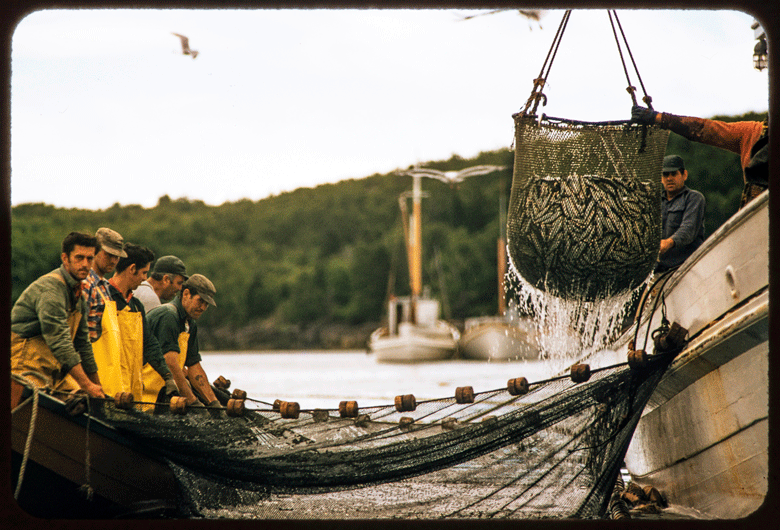Seining for herring—known in the seafood market as sardines—was a common sight on the Maine coast in 1957, but there is nothing common about the accompanying photograph. It is the work of a photographic master as evidenced in its composition and timing.
Looking at the image below, you’re met with the gaze of a fisherman holding onto a seine net. This leads the eye across the lines of the netting and floats to the lines of a sardine carrier and then up the right side of the frame to the outstretched arm of someone outside of the frame.
She was 79 feet in length and could hold 1,260 bushels of herring.
The arm is guiding a bailing net full of fish while seawater streams out, giving the appearance of a rocket taking off. A few well placed seagulls fill a couple of key spots in an empty sky and the angled horizon brings the eye back down to the fisherman.
A photo like this can hold many stories. These fishermen were working a purse seine in Long Cove on Vinalhaven in 1957. The man on the left is 25-year-old Ralph Alley of Beals Island. Third from the left is Burleigh Chandler, 19, and the man on the end with a little gray in his hair is his 44-year-old father, George, of Jonesport.
They all have since passed.
The sardine carrier they are filling is the Henry O. Underwood, one in the fleet of the world’s largest sardine factory, the William Underwood Company of Jonesport. The Henry O. Underwood was seven years old at the time of the photo, built by the General Seafoods Shipyard in Rockland in 1948-49, and it was state of the art for sardine carriers for her time.
She was 79 feet in length and could hold 1,260 bushels of herring. She was renamed the Jasper Wyman in 1985 and was last reported hauled out in South Portland in 1992.
The fishermen probably had no idea that the man in a dory making their photograph was world renowned Life magazine photographer Eliot Elisofon.
Elisofon had acquired a farmhouse on Crocket Cove on Vinalhaven in 1942 which became a summer retreat for him and his family. He cherished his time on the island and was very involved in island life.
He made photographs when he was there, not for assignments but for himself and his passion for the medium. This image was on a 35mm slide and is part of a group of nearly 2,000 slides and negatives shot between 1940-1970 that were donated to the Penobscot Marine Museum in 2020 by his daughter Elin.
While the bulk of his work is in major museums, it was important to Elin that this collection remain close to where the images were made and could be shared with the people that would appreciate them most.
The Penobscot Marine Museum has begun a campaign to raise the funds needed to digitize and catalog the collection and make it available online. Anyone who can help with this effort is encouraged to contact photo archivist Kevin Johnson at kjohnson@pmm-maine.org.
The museum, open through Oct. 15, is featuring several new exhibits including “Working the Sea,” photographs from the museum’s National Fisherman and Atlantic Fishermen collections. Also featured is “Sam Murfitt And Maine’s Working Waterfronts,” the work of photographer Sam Murfitt, who for decades photographed fishermen, their work, and their boats.





